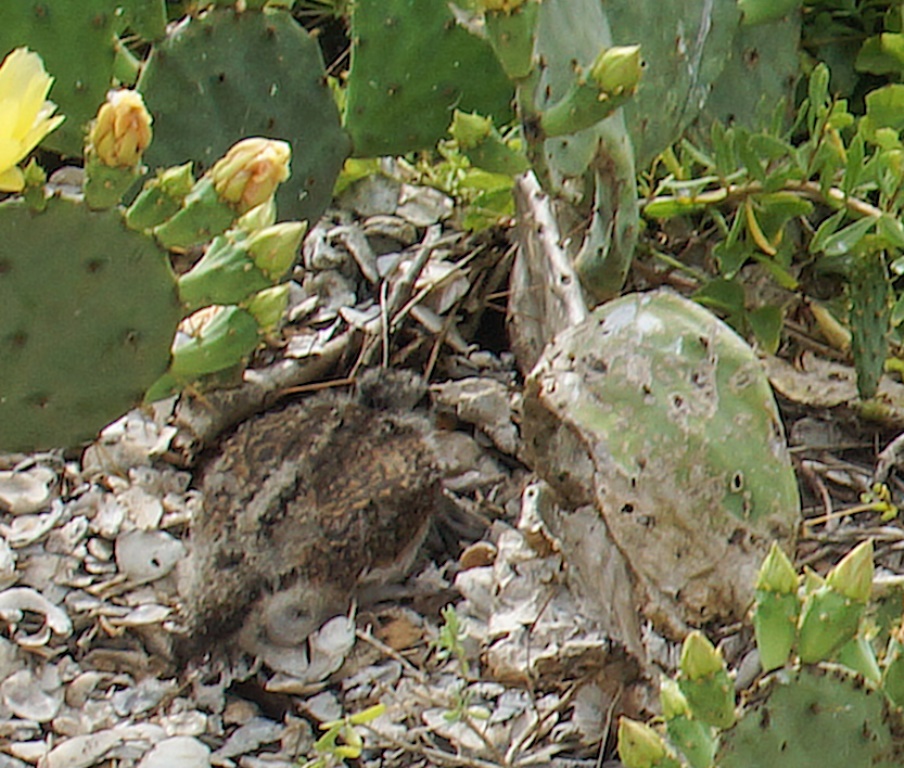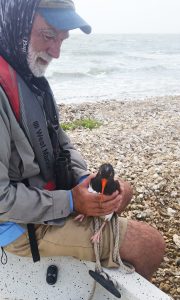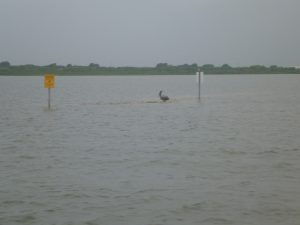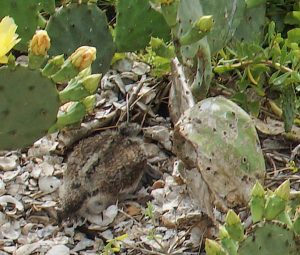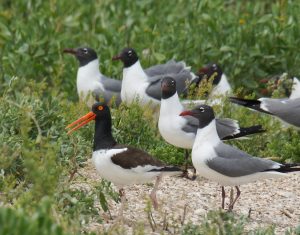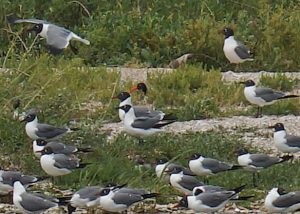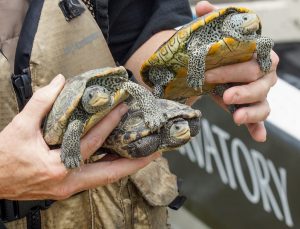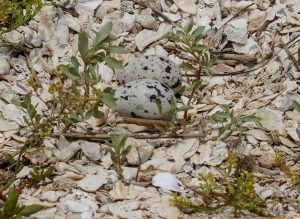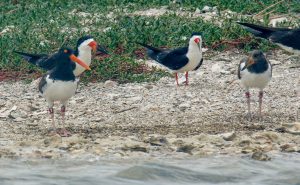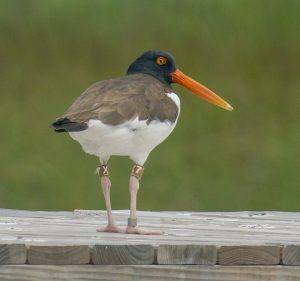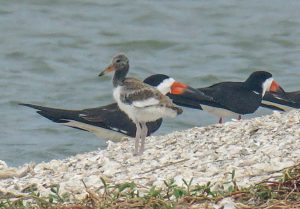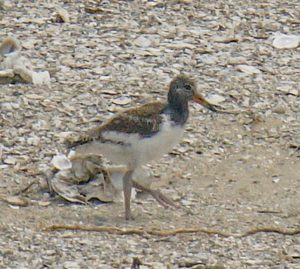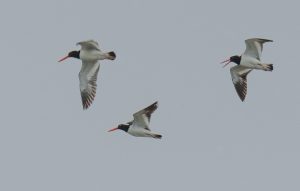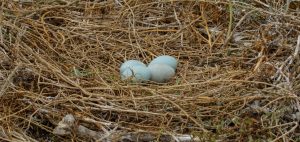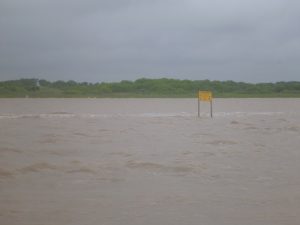By Susan Heath
Wind, wind, wind. Where does it end? I could go on but I’ll stop there. You get the drift. That’s a boat joke in case you didn’t catch it. There wasn’t an option to change our Wednesday monitoring day so even though the wind was predicted to be 18 mph we made a go of it. Alan and I were joined by Patti Trimmingham and Janet Mason. We can do pretty well in West Galveston Bay with a strong south wind which this was. An 18 mph north wind is a definite no go though. Hopefully we’re done with those until next year! It was pretty clear as soon as we headed out that a trip to Swan Lake wasn’t going to happen so we stuck to West Galveston Bay.
We did not see the boat ramp pair as we headed out which is pretty odd because they usually come and harass us when we motor by. In Jones Bay there wasn’t much happening. Alan had seen FR & unbanded chasing gulls when he was kayaking over the weekend but we did not find a nest there. Perhaps they are just sick of the gulls! CA & Y2 were standing on the breakwater around the Tiki Spoil island enjoying the sunshine. Perhaps they have given up? The Caspian and Royal Tern colony had taken over the area where 28 & AP’s nest was and the oystercatchers were at the other end of their small island. I guess they are going to have to find a spot to nest that isn’t in the middle of the terns. I love the terns but they aren’t very good at sharing the space!
We headed down the GIWW to check on ET & A8A and XE & unbanded and things got a little strange. We saw one of ET & A8A hanging out where they tried to nest a few years ago. I walked all around and didn’t find a nest so we motored off. One of them kept following us though and I remarked that something was going on there, but I didn’t know what. Then we had more strangeness with XE & unbanded. They had a one egg nest last time we were there and it looked like one of them was incubating when we pulled up but I couldn’t find the nest so I decided the bird had just been roosting. Alan suggested we set up the noose carpets to try to get the unbanded one so we did that but when we backed off they completely ignored the decoys and one of them went and laid down like it was on a nest! Sheesh. We motored back in directly to that spot and sure enough found three eggs. It wasn’t in the same place as the one last week which is why I didn’t find it I guess. I checked my nest photos when I got home and it was definitely a new nest in a different location. They work fast! The unbanded bird was incubating so we set up the box. It didn’t take too long for one of them to go in and get trapped but when I went to get it out, it was XE not the unbanded one. Dang!
XE is the chick of 11 & N3 from 2013. N3 disappeared in 2017 but 11 is hanging in there up in Swan Lake. The island where XE was hatched and reared now looks like this.
And that’s on a good day. 11 hasn’t fledged a chick since XE and probably won’t again unless we can restore an island for him.
We had to pass by ET & A8A on our way back. This time they were both there and one of them looked like it was incubating a nest. What? We went up to check and I could see two eggs from the boat. How did I miss that when I looked before? I started to feel like I was losing my oystercatcher mojo but the rest of the day went ok so maybe not.
We checked on the unbanded pair on North Deer. Last week they had a chick, but this week we only saw one of them. It appeared to be on guard so I’m pretty sure the other one was tucked away safely somewhere with the chick. W5 & unbanded were lounging away in their usual spot. Get with it guys! YM & JH were acting a bit crazy which I’ve learned to associate with chick rearing. They run, they fly, they give triple alarm calls – all actions that told us they still have a chick. I looked closely through my binoculars and saw the chick scurry up underneath a prickly pear cactus. Be careful little guy! I guess the gulls won’t bother it there though so it’s probably a good choice.
There wasn’t anything happening on Marker 52 but to my amazement we discovered that J6 & UF’s nest not only didn’t overwash but it had three eggs! There’s a long story to this pair which I’ll spare you but the short story is that UF (the female) is not the most prolific egg layer. This may be the first time ever in four nesting seasons that she’s laid three eggs. If we don’t get a super high tide they just might have a shot. Back on North Deer, C1A & unbanded were still protecting two chicks from the numerous gulls. We did not see E6A & unbanded but the wind was too strong to go in closely and look carefully so they might have been mixed in with the pelicans and gulls.
We picked our way through the reefs to South Deer and discovered that HL & unbanded had laid another egg and now have two. The nest is quite low though. All the high territory is occupied by nesting gulls so I guess that was their only refuge.
I’m still not sure what’s happening with the JN & UW. I’m leaning towards their nest failing but I wouldn’t put it past them to turn up with a chick in the next few weeks. These oystercatchers are just so sneaky! XA & unbanded and Y7 & unbanded were both still incubating their nests. Good thing because we couldn’t have gone in to investigate if we wanted to because of the wind.
Then we came to LL & unbanded. We thought they had chicks but we’d not seen them since the nest hatched so I wasn’t sure. Today we found they had a new three egg nest so that answered that question. Definitely no chicks from the previous nest. Bummer. I had high hopes for them. They still have a shot though!
The final pair on South Deer is KK & unbanded. If you remember, KK has been a bit of a wandering vagabond this season until finally last week we saw him back on his territory with his mate. I strongly suspected they would have a nest this week and indeed they did. Two eggs! Alan noticed a washed up crab trap there that appeared to have some Diamondback Terrapins in it so we investigated and found five of the poor things trapped inside. We got them all out and let the three that were still alive go.
If you’re unfamiliar with Diamondback Terrapins, they live in estuaries, tidal creeks, and saltwater marshes where they nest on sandy shorelines. These were all males which are much smaller than females. I don’t think a female could fit through the opening to get in the crab trap. One of the main threats to this species is drowning after becoming trapped in a crab trap. These little guys were doubly lucky. They didn’t drown and we found them before they starved. We all agreed we’d be checking abandoned and washed up crab traps more carefully from now on.
We headed to Gangs Bayou and saw one of A4A & unbanded with one chick. I suspect the other one was sleeping in the vegetation with the other chick. It’ll be fun trying to find those chicks to band them since they are behind the breakwater and we have to approach the island without being able to see them! JX & unbanded were up in the vegetation where they usually are. Up until this week they’ve not had much going on but this time we discovered they had a nest with two eggs. Excellent work!
We headed back up the bay to check on 16 & unbanded. Last week we saw them in a different location and thought they were working on a nest there but this week we found them back where they’ve tried to nest twice before this year and they had a new nest with two eggs. It’s a good spot if we don’t get a super high tide so maybe they’ll make it. We could see the eggs from the boat so we didn’t disembark.
Over on Jigsaw we found that all three pairs have nests again. LH & WW and T5 & T6 had both increased their egg count to three! I’m super excited that T5 & T6 thought enough of the small logs and dead palm leaves we put out to lay their nest amongst them. We put that stuff out for their chicks to hide in when their previous nest hatched but since it failed I guess they decided to take advantage of it in another way – nest concealment. Maybe we helped them out after all. YE & unbanded had laid one egg so hopefully there’s more to come. The Royal Terns had moved in over the past week and they already had eggs. Man those terns work fast!
The last island we checked was Struvi Luci. We didn’t see L9 & unbanded’s chicks on our first pass but LT & JA were there with their fledged chick U5U.
12 & unbanded had laid another egg and they now have two. Here’s hoping they do well! HM & X7’s part of the island was nearly underwater but HM was standing tall guarding it. We found X7 on a dock nearby. I wonder if she is proud of her man or sorry she picked a mate with such a lowly territory. You just never know.
We went around the backside of the island and I took a video of the skimmers so I could count them from my non-rocking couch (rather than the rocking boat). When we came back around the other side, Alan spotted both of L9 & unbanded’s chicks hanging out at the opposite end of the island from the adults. I guess the chicks are big enough now that they aren’t in danger of being eaten by a Laughing Gull. The skimmers didn’t seem to mind them being there.
We headed back towards the boat ramp and checked on the tiny island belonging to C2A & E0A. As expected their nest had overwashed. They were nowhere to be found. We still did not see the boat ramp pair when we returned to haul out the boat. I wonder if they abandoned the area?
On Friday I headed out to East Matagorda Bay with Alan and our avian technician, Amelia Grider. The wind was predicted to be 15 mph which is my limit because there’s no protection in that bay. When we got out there though it was clear the wind was higher than 15 mph. Can you say bumpy?! The tide was really high too and A7A & unbanded’s nest had overwashed. They were both there or at least there were two oystercatchers there. It was too rocky for photos. Subsequent events made me wonder if it was A7A there or a different banded bird.
We headed across the bay at a very slow pace and checked out Dressing Point. Last week we’d seen one of the pair that nests there but couldn’t find the other one on a nest anywhere. This week we saw neither of them. There are so many birds nesting there that they could easily be hidden somewhere. Once we got to the other side of the bay, where the wind didn’t have a chance to whip up the water it was much better and it was like a whole new bay out there.
At the Oyster Farm we found LF incubating a new three egg nest. He was watching me while I checked his nest and I happened to look over in the opposite direction and saw two oystercatchers. Huh? I looked back and LF was still giving me the evil eye waiting for me to leave his eggs alone. Suddenly he flew over to the other two birds though and the fireworks started. LF and mate started trying to run the other bird off.
Eventually all three landed and Alan was able to get some photos of them. A7A! You bad bad boy. What are you doing all the way down at this end of the bay? As I said, this really made me wonder if A7A was the bird we saw earlier. The pair on the other island there was not present so clearly their nest failed. Even though the habitat is not suitable, a Great Blue Heron pair has taken up residence there and laid a nest.
I wonder if that made the oystercatchers abandon the area? If I was about to bring some small chicks into the world, I certainly wouldn’t want a voracious predator like a Great Blue Heron around. The skimmers that nest there may have issues. This situation bears watching.
We headed to the west send of the bay to check on LC & R9 but they weren’t there. Did their nest fail because of the terns that moved in or did they move their chicks somewhere else to get away from the terns? It was too rough to investigate so we’ll check it next time. We headed back to Old Gulf Cut and found neither of those pairs present either. Both their islands were nearly underwater.
Where does an oystercatcher go when their island looks like that? Sad.
We got back in the GIWW where we were mostly protected from the wind and headed to check on the last pair ER & unbanded. I had high hopes that they would have chicks but they were also not present. Dang! Every nest out there failed! Poor birds. We headed in and I was very glad to be off the boat and out of the wind. Can we get a break from that next week please? If the weather forecast is correct, the answer to that question is a resounding NO.
This project is supported solely by donations and small grants. If you’d just like to make a donation (thank you!) you can do so on our website here.
Current Stats for upper Texas coast from Dickinson Bay to East Matagorda Bay: 16 nests being incubated, 42 failed nests, 5 nests with unfledged chicks, 1 nest with undetermined status, 1 chick fledged.
Note: All trapping and banding for this project is in accordance with federal and state permits issued to Susan Heath, GCBO Director of Conservation Research. Bird handling by volunteers is only permitted in the presence of Susan Heath and volunteers are trained in proper bird handling techniques.

